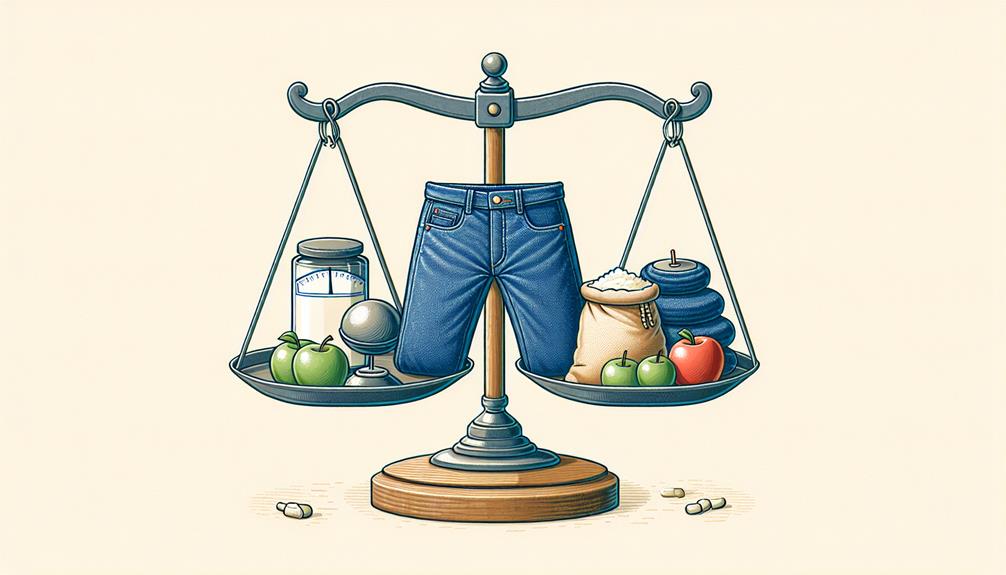Have you ever wondered how much a pair of jeans actually weighs?
I mean, is it just me, or do jeans seem to have a heft to them that's hard to pinpoint?
Well, let me tell you, the weight of jeans is a bit of a mystery that goes beyond just fabric and stitching.
So, if you're curious to uncover the secrets behind those denim scales, stick around as we unravel the factors that contribute to the weight of our beloved denim companions.
Table of Contents
Key Takeaways
- Jeans weigh 1-2 pounds, influenced by fabric type and thickness.
- Denim weight varies with material density and weave tightness.
- Lightweight denim offers breathability, while heavyweight raw denim is durable.
- Embellishments like beads and embroidery can increase jeans' weight.
Factors Affecting Jeans Weight
When it comes to the weight of jeans, various factors like the fabric type, wash, and embellishments play a significant role in determining their overall heaviness. Material density and fabric weave are key aspects affecting how heavy a pair of jeans is. Denim can vary in density based on the type of fibers used and how tightly they're woven together. A denser material will naturally weigh more than a lighter one. The fabric weave also contributes; a tighter weave tends to result in a heavier pair of jeans.
Color dye and stitching technique are other factors that influence the weight of jeans. The dyeing process can add weight to the fabric depending on the type and amount of dye used. Additionally, the stitching technique used in constructing the jeans can impact their overall heaviness. Intricate stitching or multiple layers of stitching can increase the weight of the garment. These elements combined contribute to the final weight of a pair of jeans, making them unique with regards to heaviness and feel.
Types of Denim Fabrics
Denim fabrics come in a variety of types, each offering unique characteristics and textures that influence the look and feel of jeans. Understanding the different denim options can help you choose the perfect pair tailored to your preferences. Here are some key points to explore when exploring denim fabrics:
- Raw Denim: Known for its durability and high quality, raw denim is unwashed and untreated, allowing for natural fading and creasing over time.
- Selvedge Denim: This type of denim is woven on traditional shuttle looms, resulting in a tightly woven and finished edge that prevents fraying, indicating superior fabric durability.
- Stretch Denim: Offering flexibility and comfort, stretch denim incorporates spandex or elastane into the fabric blend, allowing for ease of movement while maintaining the denim's original shape.
- Acid Wash Denim: Achieved through a bleaching process, acid wash denim provides a vintage, worn-in look, but may be less durable compared to other denim types.
Exploring these denim varieties can enhance your understanding of denim quality and fabric durability, helping you make informed decisions when selecting your next favorite pair of jeans.
Average Weight of Jeans
Jeans typically weigh around one to two pounds, depending on the style, fabric, and size. The weight of jeans is influenced by factors such as the denim thickness and material weight. Denim thickness refers to how dense the denim fabric is, affecting the overall heaviness of the jeans. Thicker denim tends to weigh more than lighter denim due to the additional material used in the weaving process. Additionally, the material weight of the denim itself plays a significant role in determining the overall weight of the jeans. Different denim materials have varying densities, with some being heavier than others. Below is a table illustrating how these factors contribute to the average weight of jeans:
| Factors | Description | Influence on Weight |
|---|---|---|
| Denim Thickness | Density of the fabric | Heavier denim = More weight |
| Material Weight | Density of the material | Heavier material = More weight |
Lightweight Vs. Heavyweight Jeans
Exploring the weight spectrum of denim bottoms, from lightweight to heavyweight, reveals how different styles cater to varied preferences and practical needs in fashion. When choosing between lightweight vs. stretchy denim or heavyweight raw denim, understanding the characteristics of each is important.
- Lightweight vs. Stretchy Denim: Lightweight denim provides breathability and flexibility, making it ideal for warmer weather or a more relaxed fit. On the other hand, stretchy denim combines the comfort of elasticity with a lighter weight, offering a snug yet comfortable feel.
- Heavyweight Raw Denim: Heavyweight raw denim, known for its durability and structured appearance, is a popular choice for individuals seeking a more rugged and long-lasting option. Although initially stiff, this type of denim softens over time, molding to the wearer's body for a personalized fit.
Whether opting for the lightweight ease of stretchy denim or the robust quality of heavyweight raw denim, the weight of your jeans can have a significant impact both on style and comfort.
Impact of Embellishments and Details
Adding intricate embellishments and unique details to your denim bottoms can elevate your outfit to a whole new level of style and individuality. When it comes to jeans, the effects of embellishments on weight can vary greatly. Beads, sequins, and embroidery can add a noticeable heft to your jeans, impacting how they feel when worn. These design elements not only affect the overall weight but also influence the way the fabric drapes and moves with your body.
Considerations for details go beyond just the aesthetic appeal. The placement of studs, patches, or decorative stitching can also affect the weight distribution of the jeans. This can impact how comfortable they're to wear throughout the day and how they conform to your body shape. When selecting embellished denim, it's crucial to balance the design impact with the practicality of weight distribution for a harmonious blend of style and comfort.
Weight Variation Across Brands
As we explore various denim brands, it's interesting to see how the weight of jeans can vary greatly across the board. When comparing different brands, the weight of the jeans is influenced by several factors, including the materials used, construction techniques, and design choices. Here are some key points to take into account when looking at weight variation across brands:
- Brand Comparison: Each brand has its own unique approach to crafting denim, leading to differences in the weight of the jeans they produce.
- Size Variations: The size of the jeans can also impact their weight, with larger sizes generally weighing more than smaller sizes due to the additional fabric used.
- Material Selection: The type of denim and other materials incorporated into the jeans can have a notable impact on their overall weight.
- Construction Methods: The way jeans are constructed, including the stitching and hardware used, can contribute to variations in weight among different brands.
Understanding these factors can help consumers make informed decisions when comparing jeans from various brands.
Men's Vs. Women's Jeans Weight
Men's and women's jeans differ not only in style and fit but also in their weight, reflecting distinct design considerations tailored to each gender.
When it comes to fit comparison, men's jeans are typically heavier than women's due to the difference in body shapes. Men's jeans are often designed with more durable materials, like thicker denim, to withstand the wear and tear of a more active lifestyle.
On the other hand, women's jeans are usually lighter in weight to provide a more comfortable and flexible fit, catering to their body contours and movements. This difference in weight can also be attributed to the varying styles and trends that each gender prefers.
Additionally, women's jeans may incorporate more stretchy materials for a form-fitting look, which can contribute to their lighter weight compared to men's jeans. Material durability plays a significant role in determining the weight of jeans, with men's jeans prioritizing sturdiness over weight, while women's jeans focus on comfort without compromising style.
Weight of Different Jeans Styles
Different jeans styles vary in weight due to the diverse materials and construction techniques used in their design. When considering the weight of jeans, factors such as denim thickness, fit, wash effects, and fabric blend play important roles.
- Denim Thickness: The weight of jeans can be influenced by the thickness of the denim used in their construction. Thicker denim typically adds more weight to the jeans.
- Fit: Slim-fit jeans may weigh less compared to relaxed-fit or bootcut styles due to the lesser amount of fabric used in their design.
- Wash Effects: Jeans with heavy wash effects like distressing or bleaching might've added embellishments that contribute to their weight.
- Fabric Blend: The blend of fabrics used in jeans, such as a mix of cotton and spandex, can affect the overall weight of the garment. Different fabric blends can result in varying weights among different jean styles.
Denim Blend Influence on Weight
I've always wondered how the blend of denim fabrics affects the weight of my jeans. It's fascinating to explore how the fabric composition impacts the overall weight, considering factors like cotton percentage and added stretch materials.
Understanding these influences can shed light on why some jeans feel heavier or lighter than others, even within the same style category.
Fabric Composition Impact
When contemplating the weight of jeans, the fabric composition, specifically the denim blend used, plays a significant role in determining the overall heaviness. Different denim blends impact the weight of jeans due to varying densities and thread counts.
Here are some key points to contemplate:
- Cotton Percentage: A higher percentage of cotton generally results in a heavier fabric.
- Synthetic Fibers: Blends with synthetic fibers like polyester can reduce weight.
- Stretch Material: Jeans with added stretch tend to be lighter than rigid denim.
- Selvage Denim: Known for its durability, selvage denim can add weight due to its intricate weaving.
Understanding the fabric composition and its impact on weight helps in choosing the right pair of jeans.
Weight Variation Factors
Considering the influence of denim blend on the weight of jeans, it is important to understand how fabric composition directly impacts the overall heaviness of the garment. Denim construction plays a significant role in determining the weight of jeans. Different blends of materials like cotton, elastane, or polyester can affect the weight, durability, and comfort of the jeans. Here is a table illustrating how denim blend influences the weight of jeans:
| Denim Blend | Weight (Ounces) | Durability | Comfort |
|---|---|---|---|
| 100% Cotton | 12 | High | Moderate |
| Cotton-Elastane | 14 | Moderate | High |
| Cotton-Polyester | 13 | High | High |
Understanding these factors can help you choose jeans that match your preferences for weight distribution and comfort.
Tips for Lightweight Travel Jeans
For those looking to travel light without sacrificing style, consider opting for lightweight travel jeans that offer both comfort and versatility. When choosing the perfect pair, keep in mind packing efficiency and the benefits of breathable materials.
Here are some tips to help you find the ideal lightweight travel jeans:
- Material Matters: Look for jeans made from lightweight and breathable fabrics like cotton, polyester, or a blend of both. These materials will keep you comfortable during long travels.
- Stretch is Key: Opt for jeans with a bit of stretch for added comfort and flexibility. This feature will allow you to move freely and stay comfortable throughout your journey.
- Adaptable Styles: Choose a classic style that can easily shift from day to night. This way, you can pack fewer items and still have various outfit options.
- Neutral Colors: Stick to neutral colors like black, navy, or gray. These shades are easy to mix and match with other clothing items, allowing you to create multiple outfits with minimal pieces.
Frequently Asked Questions
Are There Any Health Concerns Associated With Wearing Heavy Jeans?
Weight distribution in heavy jeans can lead to muscle strain. It's important to be mindful of how your body feels when wearing them. Stretch breaks and proper posture can help prevent discomfort and potential health issues.
How Does the Weight of Jeans Impact Their Durability and Longevity?
The weight of jeans affects their durability and longevity. Heavier jeans may last longer but can impact comfort. Manufacturing processes play a role in balancing weight and quality. Finding the right balance is key for longevity.
Can the Weight of Jeans Affect How They Fit and Feel on the Body?
When it comes to jeans, weight impacts how they fit and feel. Heavier denim may offer durability but can be less comfortable with movement restriction. Lighter jeans are trendy, but personal brand preference plays a role in choosing the right pair.
Are There Any Environmental Implications Related to the Weight of Jeans?
When considering the weight of jeans, it's important to understand the environmental impact. Brands adopting sustainable practices help reduce water usage and carbon emissions. Supporting eco-friendly options can make a positive difference in our world.
Do Jeans of Different Colors or Washes Typically Weigh Differently?
When it comes to jeans, the color impact and wash variation can indeed affect the weight. Darker jeans tend to be heavier due to more dye, while distressed or lighter washes may weigh less. It's fascinating how these factors influence jeans' weight.
- Supima Sheets Explained: Are They Sateen or Percale? - July 14, 2025
- Are Boll and Branch Sheets Percale? a Deep Dive Into Their Weave - July 14, 2025
- A Guide to Buying Old-Fashioned Percale Sheets for a Classic, Crisp Feel - July 14, 2025







